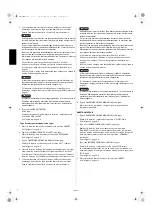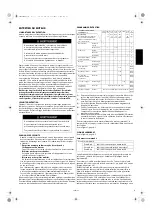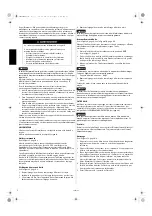
ENGLISH
2
BEFORE OPERATION CHECKS
IS YOUR ENGINE READY TO GO?
For your safety, to ensure compliance with environmental regulations,
and to maximize the service life of your equipment, it is very important to
take a few moments before you operate the engine to check its
condition. Be sure to take care of any problem you find, or have your
servicing dealer correct it, before you operate the engine.
Before beginning your pre-operation checks, be sure the engine is level
and stopped.
Always check the following items before you start the engine:
Check the General Condition of the Engine
1. Look around and underneath the engine for signs of oil or gasoline
leaks.
2. Remove any excessive dirt or debris, especially around the muffler
and top cover.
3. Look for signs of damage.
4. Check that all shields and covers are in place, and all nuts,
bolts, and screws are tightened.
Check the Engine
1. Check the fuel level (see page 4). Starting with a full tank will help to
eliminate or reduce operating interruptions for refueling.
2. Check the engine oil level (see page 5). Running the engine with a
low oil level can cause engine damage.
3. Check the air filter element (see page 5). A dirty air filter element will
restrict air flow to the carburetor, reducing engine performance.
4. Check the amount of battery charge (see page 6).
5. Check the equipment powered by this engine.
Review the instructions provided with the equipment powered by
this engine for any precautions and procedures that should be
followed before engine startup.
OPERATION
SAFE OPERATING PRECAUTIONS
Before operating the engine for the first time, please review the
SAFETY
INFORMATION
BEFORE OPERATION CHECKS
on
Carbon Monoxide Hazards
For your safety, do not operate the engine in an enclosed area such as a
garage. Your engine’s exhaust contains poisonous carbon monoxide gas
that can collect rapidly in an enclosed area and cause illness or death.
Review the instructions provided with the equipment powered by this
engine for any safety precautions that should be observed with engine
startup, shutdown or operation.
Do not operate the engine on slopes greater than 15° (26%).
Battery Handling
If you do not follow the instructions below, it may cause short circuit, heat
generation, ignition, gas injection, and liquid leakage.
• Do not disassemble and modify the battery.
• Do not apply strong impacts such as dropping or putting heavy thing on.
• If the battery falls into water, do not continue to use same battery.
• Do not remove the label attached to the top of the battery.
STARTING THE ENGINE
Do not use the choke if the engine is warm or the air temperature is high.
• Manual Choke Type (applicable types)
1. Turn the fuel valve lever to the ON position.
See Figure 1, page A-2.
2. [Without CHOKE LEVER type] (applicable types)
Move the control lever to the CLOSED (CHOKE) position.
See Figure 2, page A-2.
3. With FLYWHEEL BRAKE LEVER type (applicable types):
Move the flywheel brake lever to the RELEASED position. The engine
switch, which is linked with the flywheel brake lever, is turned on
when the flywheel brake lever is moved to the RELEASED position.
See Figure 3, page A-2.
4. Clutch the brake lever of the equipment powered by this engine.
The battery indicator lights on or flashes for 5 seconds to indicate the
battery charge state (see page 6) when the brake lever of the
equipment powered by this engine is clutched.
Failure to properly maintain this engine, or failing to
correct a problem before operation, could result in a
significant malfunction.
Some malfunctions can cause serious injuries or death.
Always perform a pre-operation inspection before each
operation and correct any problems.
Exhaust contains poisonous carbon monoxide gas that
can build up to dangerous levels in closed areas.
Breathing carbon monoxide can cause unconsciousness
or death.
Never run the engine in a closed, or even partly closed
area.
If some problem such as odor, heat generation,
deforming, and discoloring occur during using, storing,
charging the battery, stop using the battery immediately.
If battery leaks get on your skin or clothes, rinse with clean
water.
If battery leaks splash into your eyes, rinse thoroughly
with clean water and get medical attention immediately
without rubbing your eyes.
Failure to do so can cause eye damage.
3RZ9S8000.book 2 ページ 2019年9月3日 火曜日 午後4時17分








































